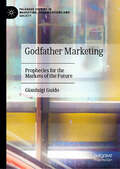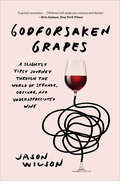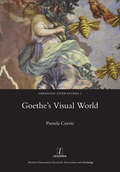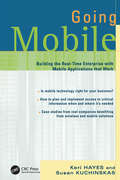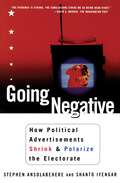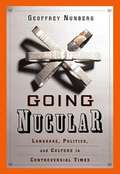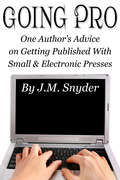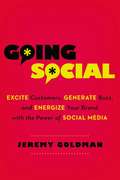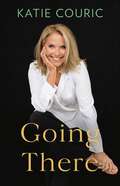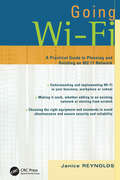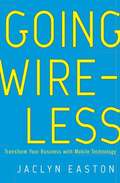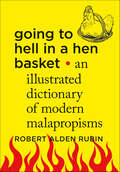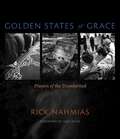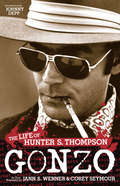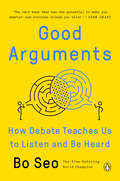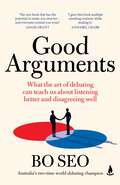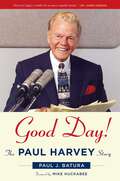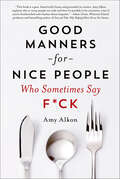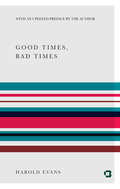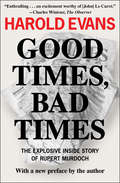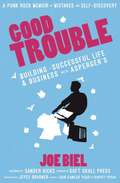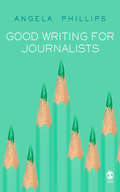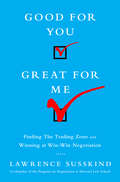- Table View
- List View
Godfather Marketing: Prophecies for the Markets of the Future (Palgrave Studies in Marketing, Organizations and Society)
by Gianluigi GuidoIn a landscape marked by uncertainties stemming from global instability, societal fragmentation, and rapid technological advancements, consumers will be seeking immediate satisfaction for their vital needs and desires. To address this issue, firms will be called upon to grant favors even before selling products, offering solutions to consumers in exchange for their unwavering loyalty. This compelling book presents a unique and provocative new vision of future markets, where firms evolve into organizations reminiscent of “mafia families” stripped of criminal connotations, establishing relationships with their customers based on satisfaction, reciprocation, recognition of merit, and punishment of wrongdoing. In a “Credibility Economy”, where the quality of information supersedes its quantity, especially with the development of AI, this approach gives firms a competitive edge through the creation of a trusted network grounded in a code of honor. Godfather Marketing offers an engaging, accessible, and fresh perspective on marketing, where readers will discover unique insights on consumer behavior and market dynamics, highlighting how they can benefit the broader community, provided appropriate measures are taken to safeguard personal freedom.
Godforsaken Grapes: A Slightly Tipsy Journey through the World of Strange, Obscure, and Underappreciated Wine
by Jason WilsonA New York Times and Smithsonian Magazine best book, this &“genial excursion&” to little-known wine destinations &“will make you curious and thirsty.&” (Eric Asimov, The New York Times). Eighty percent of the wine we drink is made from only twenty grapes. Yet, there are nearly 1,400 known varieties of wine grapes in the world—from altesse to zierfandler. In Godforsaken Grapes, Jason Wilson looks at how that came to be and embarks on a journey to discover what we miss. Stemming from his own growing obsession, Wilson moves far beyond the &“noble grapes,&” hunting down obscure and underappreciated wines from Switzerland, Austria, Portugal, France, Italy, the United States, and beyond. In the process, he looks at why these wines fell out of favor (or never gained it in the first place), what it means to be obscure, and how geopolitics, economics, and fashion have changed what we drink. A combination of travel memoir and epicurean adventure, Godforsaken Grapes is an entertaining love letter to wine. &“You&’ll walk away with a better understanding of the wine industry and an itch to book a ticket to destinations you&’ve never heard of before.&” —Imbibe Magazine &“Funny, enlightening [and] prodigiously researched.&” —San Francisco Chronicle &“Wilson offers a spirited, highly personal argument for drinking more adventurously.&” —Punch &“A delightful dive into more esoteric grapes.&” —Minneapolis Star-Tribune &“Wonderful . . . [you&’ll] never order another pinot noir again.&” —Tom Bissell, author of Apostle and The Disaster Artist &“Original, obsessive, and wildly insightful. Drink it down!&” —Andrew McCarthy, actor, director, and author of the New York Times bestselling travel memoir The Longest Way Home
Goethe's Visual World
by Pamela CurrieGoethe's ideas on colour and imagery crossed many borderlines: those of artistic processes and philosophical aesthetics, art history and colour theory, together with the science of perception. This investigation into his writings ranges across art from Antiquity, the Renaissance and the eighteenth century, as well as exploring the centrality of these issues to Goethe's literary work. Questions find answers, but also raise new questions. This systematic sequence of essays, originally written between 1999 and 2011, appeals to readers in all these separate areas, while drawing together their essential coherence.
Going Mobile: Building the Real-Time Enterprise with Mobile Applications that Work
by Keri Hayes...this is the first business book to come through my desk which merits a mention of good content. ... I liked the content in the fact that it gave me an overview from a business perspective. The book brings smart information for the uninformed manager
Going Negative: How Political Advertisements Shrink & Polarize the Electorate
by Shanto Iyengar Stephen AnsolabeherePolitical advertising has been called the worst cancer in American society. Ads cost millions, and yet the entire campaign season is now filled with nasty and personal attacks. In this landmark six-year study, two of the nation's leading political scientists show exactly how cancerous the ad spot has become. 16 illustrations.
Going Nucular: Language, Politics, and Culture in Confrontational Times
by Geoffrey NunbergNunberg (linguistics, Stanford U.) does not spend much time on the romance of words or decrying the state of the language, but more often takes language as a jumping off point to see what words can reveal about other things, among them culture, war, politics, symbols, media, business, and technology. Many of the 65 essays began life as articles or radio commentaries.
Going Pro
by J. M. SnyderGoing Pro: One Author’s Advice on Getting Published with Small and Electronic Pressesis a concise guide that offers advice on all aspects of writing for publication. From finding the time to write to finding beta readers, from navigating all the elements of a successful submissions packet to understanding a publishing contract to marketing your newly published book -- here I offer the best advice I can on getting your first story from a file on your computer to an e-book released by a small or electronic press.Topics covered include: polishing your manuscript, finding the right publisher, working with an editor, writing blurbs, and promoting your book. I give detailed explanations of submission guidelines, contracts, rights and copyrights, cover art, and marketing plans. I also offer advice on what to do when things don’t go quite as you plan, whether it’s a bad review or a pirate site, or your publisher folds.It can be intimidating when you’re just starting out and trying to get published. I know, I’ve been there, too. So if you’re interested in getting your stories published with a small press or e-book publisher, let me help you through the process!
Going Social: Excite Customers, Generate Buzz, and Energize Your Brand with the Power of Social Media
by Jeremy GoldmanIf you're not social, it's like you're not even there. That's how critical social media marketing has become. Businesses everywhere are struggling to adapt, but transitioning from traditional marketing to online engagement is fraught with questions, such as: How much is a Facebook "like" worth? How can you effectively engage online influencers? What are the best dashboards for monitoring multiple social channels simutaneously? How do you keep it all going around the clock? For more than a decade, author Jeremy Goldman has helped companies inject "social" into their processes. In Going Social, he explains the ins-and-outs of platforms such as Facebook,Twitter, LinkedIn, Google+, Foursquare, Instagram, Pinterest, and others - and shows readers how to: - Formulate a social strategy - Pinpoint their audience and where they "live" online - Give their brand a unique voice and personality - Get good at listening - Create relevant, engaging content - Identify and reward influencers - Build strong bonds with bloggers - Become truly customer-centric - Avoid pitfalls when possible - and respond to negative feedback when a misstep is made - Cultivate brand spokespeople - Use targeting to engage more effectively - Turn employees into social marketers - Engage with ROI in mind The digital landscape offers unprecedented opportunities to breathe new life into brands, spread the word about products, and magnify loyalty. Featuring insights from entrepreneurs, social media directors, community managers, bloggers, and other experts, Going Social is an indispensable guide to connecting with customers in the brave new social frontier.
Going There
by Katie CouricHeartbreaking, hilarious, and brutally honest, Going There is the deeply personal life story of a girl next door turned household name. <P><P>For more than forty years, Katie Couric has been an iconic presence in the media world. In her brutally honest, hilarious, heartbreaking memoir, she reveals what was going on behind the scenes of her sometimes tumultuous personal and professional life - a story she’s never shared, until now. Of the medium she loves, the one that made her a household name, she says, “Television can put you in a box; the flat-screen can flatten. On TV, you are larger than life but smaller, too. It is not the whole story, and it is not the whole me. This book is. <P><P>”Beginning in early childhood, Couric was inspired by her journalist father to pursue the career he loved but couldn’t afford to stay in. Balancing her vivacious, outgoing personality with her desire to be taken seriously, she overcame every obstacle in her way: insecurity, an eating disorder, being typecast, sexism . . . challenges, and how she dealt with them, setting the tone for the rest of her career. Couric talks candidly about adjusting to sudden fame after her astonishing rise to co-anchor of the TODAY show, and guides us through the most momentous events and news stories of the era, to which she had a front-row seat: Rodney King, Anita Hill, Columbine, the death of Princess Diana, 9/11, the Iraq War . . . In every instance, she relentlessly pursued the facts, ruffling more than a few feathers along the way. She also recalls in vivid and sometimes lurid detail the intense pressure on female anchors to snag the latest “get”—often sensational tabloid stories like Jon Benet Ramsey, Tonya Harding, and OJ Simpson. <P><P>Couric’s position as one of the leading lights of her profession was shadowed by the shock and trauma of losing her husband to stage 4 colon cancer when he was just 42, leaving her a widow and single mom to two daughters, 6 and 2. The death of her sister Emily, just three years later, brought yet more trauma—and an unwavering commitment to cancer awareness and research, one of her proudest accomplishments. Couric is unsparing in the details of her historic move to the anchor chair at the CBS Evening News—a world rife with sexism and misogyny. Her “welcome” was even more hostile at 60 Minutes, an unrepentant boys club that engaged in outright hazing of even the most established women. In the wake of the MeToo movement, Couric shares her clear-eyed reckoning with gender inequality and predatory behavior in the workplace, and downfall of Matt Lauer—a colleague she had trusted and respected for more than a decade. <P><P>Couric also talks about the challenge of finding love again, with all the hilarity, false-starts, and drama that search entailed, before finding her midlife Mr. Right. Something she has never discussed publicly—why her second marriage almost didn’t happen. If you thought you knew Katie Couric, think again. Going There is the fast-paced, emotional, riveting story of a thoroughly modern woman, whose journey took her from humble origins to superstardom. In these pages, you will find a friend, a confidante, a role model, a survivor whose lessons about life will enrich your own. <P><P><b>A New York Times Best Seller</b>
Going Wi-Fi: Networks Untethered with 802.11 Wireless Technology
by Janice ReynoldsMake informed decisions about planning and installing 802.11 'Wi-Fi' wireless networks. This book helps you tackle the challenge, whether installing Wi-Fi within an existing corporate network or setting up a wireless network from scratch in any business
Going Wireless
by Jaclyn EastonGoing Wireless delivers the unexpected by showing how wireless is transforming every type of enterprise from micro-businesses to multi-national conglomerates.Award-winning technology journalist Jaclyn Easton begins with an in-depth look at owning your customers and clients through mobile commerce-whether your company focuses on consumers or business-to-business.From there you will learn about the advantages of wirelessly fortifying your mobile workforce of itinerant executives, sales personnel, and field service technicians as well as how wireless is dramatically redefining customer service, marketing, and advertising.Going Wireless also delves deep inside the corporation. First you'll find out why most companies are "handsizing" in addition to deploying wireless technology to rejuvenate warehouses, supply chains, procurement procedures, data collection, competitive intelligence, and much more.The best part is that these scenarios are supported by over 40 brand-name success stories, including:How Sears saves millions by wirelessly enabling 100 percent of their appliance repair technicians;How the Gap proved that by sewing wireless technology in their clothing they could reduce labor distribution costs by 50 percent;How McKessanHBOC-a Fortune 40 corporation-used mobile technology to entirely eliminate all their manifest imaging costs.While most people associate wireless with cell phones and Palm handhelds, you'll also learn that wireless has been around for over 100 years and has spawned mobile options you've never heard of and is being used in ways you've never imagined.This makes Going Wireless the perfect book for executives and managers who need a comprehensive overview of the wireless options that can make their companies more competitive, more productive, and more profitable.
Going the Distance: Ringside 2 (Ringside Series #3)
by Jennifer FuscoWelcome to Vegas. You've got ringside seats to the world's hottest boxing match. Watch fearless champions. Meet the women that knock them off their feet. Fans of Katy Evans, Jamie McGuire and RJ Prescott - let's get ready to ruuummble. Middleweight boxer Michael Perez will do whatever it takes to reach the top. With his next fight at Madison Square Garden he's so close - but he needs to drive himself across the country first. When his manager insists a sports reporter tag along, Michael finds himself under the watchful eye of Ava Phillips for the epic road-trip.Ava has made a career out of exposing the underbelly of professional sports. Instinct tells her that Michael's squeaky clean image is a cover - and she's determined to find out more. On the drive from Nevada to New York, things soon start to heat up. But when Ava unearths Michael's past, will she expose his darkness or succumb to pure passion? Ready for round three? Don't miss the third thrilling Ringside book, The Hardest Hit. And return to the world of Stamina in Book One, Fighting For It.
Going to Hell in a Hen Basket: An Illustrated Dictionary of Modern Malapropisms
by Robert Alden Rubin“A pain staking but hilarious journey amidst the strings and arrows of language misfortune . . . The result is the perfect gift book for word nerds.” —BrevityMalapropism—A word or phrase that has been mistaken for another, usually because of its sound rather than its meaning.Everyone has made the mistake of using a word or phrase that they think sounds correct, but in fact is not. Malapropisms make some sense. They have a semantic logic to them, even if that logic makes perfect nonsense. In Going to Hell in a Hen Basket, author Robert Alden Rubin delights in the creative misuse of words and celebrates the verbal and textual flubs that ignore the conventions of proper English.Culled from blogs, the deepest corners of the internet, as well as some of the most esteemed publications, here is a collection of classic malapropisms paired with hilarious illustrations.Examples include:adieu, without further—Conflation of bidding adieu (saying goodbye) with ado (complicated doings, ceremony) to mean “without saying anything more.”feeble position—An unborn child in a fetal position seems weak and helpless, which explains the confusion here. The two words also share some sexist cultural and literary associations. Feeble (weak) originates from a Latin word for something to be wept over; fetal (relating to a fetus) originates from the same preliterate Indo-European word that gives us female.Perfect for bookworms and wordsmiths, the point here isn’t to shame the malapropagandists, but to delight in the twists and turns writers put our language through and to amuse and inform those of us who care about words.
Golden States of Grace: Prayers of the Disinherited
by Rick NahmiasTaking California as a window into the diversity of religion in America, Golden States of Grace documents marginalized communities at prayer in their own faith traditions. The collection is thoroughly interfaith, introducing us to the nation's only halfway house for addicts self-identified as Jewish, a transsexual gospel choir, a Buddhist community in San Quentin, a Mormon congregation organized by the deaf for the deaf, Latina sex workers worshipping the female folk deity Santísima Muerte, and more. Depictions of conventional middle-class religion are widely visible in the media, but the American public rarely sees the sacred worlds of society's marginalized: the outcasts, the fallen, those that have been labeled "other" - ironically, those whom religion aims to serve. The poignant stories Nahmias has gathered here cross numerous boundaries and ask difficult questions few outsiders have been willing to pose.
Gonzo: The Life of Hunter S. Thompson
by Corey Seymour Johnny Depp Jann S. WennerFew American lives are stranger, more action-packed, or wilder than that of Hunter S. Thompson. Born a rebel in Louisville , Kentucky, Thompson spent a lifetime channeling his energy and insight into such landmark works as Fear and Loathing in Las Vegas - and his singular and provocative style challenged and revolutionized writing. Now, for the first time ever, Jann Wenner and Corey Seymour have interviewed the Good Doctor's friends, family, acquaintances and colleagues and woven their memories into a brilliant oral biography. From Hell's Angels leader Sonny Barger to Ralph Steadman to Jack Nicholson to Jimmy Buffett to Pat Buchanan to Marilyn Manson and Thompson's two wives, son, and longtime personal assistant, more than 100 members of Thompson's inner circle bring into vivid focus the life of a man who was even more complicated, tormented, and talented than any previous portrait has shown. It's all here in its uncensored glory: the creative frenzies, the love affairs, the drugs and booze and guns and explosives and, ultimately, the tragic suicide. As Thompson was fond of saying, "Buy the ticket, take the ride."
Good Arguments: How Debate Teaches Us to Listen and Be Heard
by Bo Seo&“The rare book that has the potential to make you smarter—and everyone around you wiser.&” —Adam Grant Two-time world champion debater and former coach of the Harvard debate team, Bo Seo tells the inspiring story of his life in competitive debating and reveals the timeless secrets of effective communication and persuasionWhen Bo Seo was 8 years old, he and his family migrated from Korea to Australia. At the time, he did not speak English, and, unsurprisingly, struggled at school. But, then, in fifth grade, something happened to change his life: he discovered competitive debate. Immediately, he was hooked. It turned out, perhaps counterintuitively, that debating was the perfect activity for someone shy and unsure of himself. It became a way for Bo not only to find his voice, but to excel socially and academically. And he&’s not the only one. Far from it: presidents, Supreme Court justices, and CEOs are all disproportionally debaters. This is hardly a coincidence. By tracing his own journey from immigrant kid to world champion, Seo shows how the skills of debating—information gathering, truth finding, lucidity, organization, and persuasion—are often the cornerstone of successful careers and happy lives.Drawing insights from its strategies, structure, and history, Seo teaches readers the skills of competitive debate, and in doing so shows how they can improve their communication with friends, family, and colleagues alike. He takes readers on a thrilling intellectual adventure into the eccentric and brilliant subculture of competitive debate, touching on everything from the radical politics of Malcom X to Artificial Intelligence. Seo proves beyond a shadow of a doubt that, far from being a source of conflict, good-faith debate can enrich our daily lives. Indeed, these good arguments are essential to a flourishing democracy, and are more important than ever at time when bad faith is all around, and our democracy seems so imperiled.
Good Arguments: What the art of debating can teach us about listening better and disagreeing well
by Bo SeoAt a time when every disagreement turns toxic, world champion debater Bo Seo reveals the timeless secrets of effective communication and persuasion.When Bo Seo was 8 years old, he and his family migrated from Korea to Australia. At the time, he did not speak English, and, unsurprisingly, struggled at school. But, then, in year five, something happened to change his life: he was introduced to debating.Immediately, he was hooked. It turned out, perhaps counterintuitively, that debating was the perfect activity for someone shy and unsure of himself. It became a way for Bo not only to find his voice, but to excel socially and academically. He went on to win world titles with the Australian schools and Harvard University teams.But debating isn&’t just about winning or losing an argument: it&’s about information gathering, truth finding, lucidity, organization, and persuasion. It&’s about being able to engage with views you disagree with, without the argument turning toxic.Good Arguments shares insights from the strategy, structure and history of debating to teach readers how they might better communicate with friends, family and colleagues. Touching on everything from the radical politics of Malcom X to Artificial Intelligence, Seo proves beyond a shadow of a doubt that, far from being a source of conflict, good-faith debate can enrich our daily lives. Indeed, these good arguments are more important than ever at time when bad faith is all around, and our democracy seems so imperiled.&‘From two-time world champion debater Bo Seo, a thoughtful, instructive and eloquent meditation on the art of debate and why its central pillars - fact-finding, reason, persuasion and listening to opponents - are so valuable in today&’s alarming ecosystem of misinformation and extreme emotion. When Bo Seo&’s family immigrated from South Korea to Australia, he was a shy, conflict-averse eight year old who worried about being an outsider, and in &“Good Arguments,&” he recounts how debate not only helped him to cross language lines, but also gave him confidence and a voice of his own.&’ Michiko Kakutani, former chief book critic for The New York Times.
Good Charts: The HBR Guide to Making Smarter, More Persuasive Data Visualizations
by Scott BerinatoDataviz-the new language of businessA good visualization can communicate the nature and potential impact of information and ideas more powerfully than any other form of communication.For a long time "dataviz" was left to specialists-data scientists and professional designers. No longer. A new generation of tools and massive amounts of available data make it easy for anyone to create visualizations that communicate ideas far more effectively than generic spreadsheet charts ever could.What's more, building good charts is quickly becoming a need-to-have skill for managers. If you're not doing it, other managers are, and they're getting noticed for it and getting credit for contributing to your company's success.In Good Charts, dataviz maven Scott Berinato provides an essential guide to how visualization works and how to use this new language to impress and persuade. Dataviz today is where spreadsheets and word processors were in the early 1980s-on the cusp of changing how we work. Berinato lays out a system for thinking visually and building better charts through a process of talking, sketching, and prototyping.This book is much more than a set of static rules for making visualizations. It taps into both well-established and cutting-edge research in visual perception and neuroscience, as well as the emerging field of visualization science, to explore why good charts (and bad ones) create "feelings behind our eyes." Along the way, Berinato also includes many engaging vignettes of dataviz pros, illustrating the ideas in practice.Good Charts will help you turn plain, uninspiring charts that merely present information into smart, effective visualizations that powerfully convey ideas.
Good Day!: The Paul Harvey Story
by Paul BaturaGood Day!, the critically-acclaimed biography about the legendary Paul Harvey, is now in paperback! In this heartwarming book, author Paul J. Batura tells the all-American story of one of the best-known radio voices in history. From his humble beginnings to his unparalleled career of more than 50 years with ABC radio, Paul Harvey narrated America's story day by day, through wars and peace, through the threat of communism and the crumbling of old colonial powers, through consumer booms and eventual busts. In Good Day!, you'll follow,* How he became "Paul Harvey"* The remarkable adversity he confronted in his early years* How he revolutionized the radio industry with his wife, Evelyn* How a president wanted to "roast" him "good"* How he was nearly jailed for pursuing a scoopUplifting and inspirational, Good Day! is a colorful biography of the radio pioneer-turned-legend whose guiding light saw the country through dark times. Whether he was covering racial tensions, terrorist attacks, or which vitamins to take, Paul Harvey articulated the American experience for average people making their way in a world too large for quick comprehension. Harvey brought them that world "in dime store words," with a sense of optimism and faith, and with a deep love for America. Here is Harvey's story, the rest of the story, as he would tell it himself.
Good Manners for Nice People Who Sometimes Say F*ck
by Amy Alkon“A gem . . . Alkon explains why so many people are rude and how it’s possible to be courteous, even if you’re foul-mouthed and clueless about etiquette.” —Dr. Adam Grant, Wharton School professor and New York Times–bestselling authorTo lead us out of the miasma of modern mannerlessness, science-based and bitingly funny syndicated advice columnist Amy Alkon rips the doily off the manners genre and gives us a new set of rules for our twenty-first century lives.With wit, style, and a dash of snark, Alkon explains that we now live in societies too big for our brains, lacking the constraints on bad behavior that we had in the small bands we evolved in. Alkon shows us how we can reimpose those constraints, how we can avoid being one of the rude, and how to stand up to those who are.Foregoing prissy advice on which utensil to use, Alkon answers the twenty-first century’s most burning questions about manners, including:Why do many people, especially those under forty, now find spontaneous phone calls rude?What can you tape to your mailbox to stop dog walkers from letting their pooch violate your lawn?How do you shut up the guy in the pharmacy line with his cellphone on speaker?What small gift to your new neighbors might make them think twice about playing Metallica at 3 a.m.?Combining science with more than a touch of humor, Good Manners for Nice People Who Sometimes Say F*ck is destined to give good old Emily a shove off the etiquette shelf (if that’s not too rude to say).“Miss Manners with fangs.” —LA Weekly
Good Times, Bad Times
by Sir Harold EvansIn Harold Evans’s classic memoir, he tells the inside story of Rupert Murdoch’s takeover of the Times of London and his rise to become a global media powerIn 1981, Harold Evans was the editor of one of Britain’s most prestigious publications, the Sunday Times, which had thrived under his watch. When Australian publishing baron Rupert Murdoch bought the daily Times of London, he persuaded Evans to become its editor with guarantees of editorial independence. But after a year of broken promises and conflict over the paper’s direction, Evans departed amid an international media firestorm. Evans’s story is a gripping behind-the-scenes look at Murdoch’s ascension to global media magnate. It is Murdoch laid bare, an intimate account of a man using the power of his media empire for his own ends. Riveting, provocative, and insightful, Good Times, Bad Times is as relevant today as when it was first written. This book features a new preface by the author, in which he discusses the Rupert Murdoch phone-hacking scandal.
Good Times, Bad Times: The Explosive Inside Story of Rupert Murdoch
by Harold EvansA renowned journalist&’s &“vivid&” account of his battle with Murdoch after the global media baron bought the Times of London (Chicago Tribune). In 1981, Harold Evans was the editor of one of Britain&’s most prestigious publications, the Sunday Times, which had thrived under his watch. When Australian publishing baron Rupert Murdoch bought the daily Times of London, he persuaded Evans to become its editor with guarantees of editorial independence. But after a year of broken promises and conflict over the paper&’s direction, Evans departed amid an international media firestorm. Evans&’s story is a gripping, behind-the-scenes look at Murdoch&’s ascension to global media magnate. It is Murdoch laid bare, an intimate account of a man using the power of his media empire for his own ends. Riveting, provocative, and insightful, Good Times, Bad Times is as relevant today as when it was first written. With details on the scandalous deal between Murdoch and Margaret Thatcher, this updated ebook edition includes an extensive new preface by Evans, the New York Times–bestselling author of Do I Make Myself Clear?, discussing the Rupert Murdoch phone-hacking scandal.
Good Trouble: Building a Successful Life and Business with Asperger's (Punx Ser.)
by Sander Hicks Joe Biel Joyce Brabner<p>In 1996, everything about Joe Biel's life seemed like a mistake. He was 18, he lived in Cleveland, he got drunk every day, and he had mystery health problems and weird social tics. <p>All his friends' lives were as bad or worse. To escape a nihilistic, apocalyptic worldview and to bring reading and documentation into a communal punk scene, he started assembling zines and bringing them in milk crates to underground punk shows. Eventually this became Microcosm Publishing. But Biel's head for math was stronger than his ability to relate to people, and it wasn't until he was diagnosed with Asperger's Syndrome that it all began to fall into place. <p>This is the story of how, over 20 years, one person turned a litany of continuing mistakes and seeming wrong turns into a happy, fulfilled life and a thriving publishing business that defies all odds.</p>
Good Writing for Journalists
by Ms Angela Phillips'The ultimate book on the creative skills of journalism' - Writing Magazine 'Useful and timely... it is refreshing to discover a book so overtly designed to inspire students to think about what can make writing good - or even great.' - Media International Australia This is a book about the art of writing for newspapers and magazine, but doesn't look at punctuation, spelling and the stylistic conventions of 'everyday' journalism. Instead, Good Writing For Journalists presents extended examples of writing which are powerful, memorable, colourful or funny. Each piece will be contextualised and analysed encouraging readers to learn from the best practitioners. This book will inspire those who want to make their writing individual and memorable. Along the way the major elements of non-fiction writing will be introduced, in chapters organised by genre - profile writing, reportage, news analysis, investigation, sports writing, personal and opinion columns and 'lifestyle' among them. Phillip's book sees itself as a natural successor to Wolfe & Johnson's seminal The New Journalism (1975). By adopting a larger sweeping and tailoring itself for the contemporary journalistic arena, this book will be an essential purchase for the discerning journalist and journalism student.
Good for You, Great for Me: Finding the Trading Zone and Winning at Win-Win Negotiation
by Lawrence Susskind"Win-win" negotiation is an appealing idea on an intellectual level: Find the best way to convince the other side to accept a mutually beneficial outcome, and everyone gets their fair share. The reality, though, is that people do not want a fair share; they want to win. Tell your boss that you concocted a deal where your company got its piece of the pie, and the reaction is likely to be: "Maybe we need to find someone harder-nosed than you who knows how to win." However, to return to an earlier era before "win-win" negotiation was in fashion and seek simply to dominate or bully grudging opponents into submission would be a step in the wrong direction- and a public relations disaster.Into this dilemma steps renowned expert Lawrence Susskind with a brilliant new negotiation paradigm he calls "the trading zone." Good for You, Great for Me provides the missing operational guidelines for winning negotiations in business, family disputes, international relations, or public affairs without undermining trust or ruining relationships. It provides not just new principles but new tools- six operational steps to take after you've found your way into the trading zone- to ensure you get as large a share of the pie as possible.Good for You, Great for Me also provides guidance for handling special situations such as dealing with huge power differentials (the 900 pound gorilla), liars, and irrational people; the addition of lots more parties to the negotiation; a history of bad relationships; negotiating when the relationship is too important to lose; and trying to make deals in cross-cultural situations.
